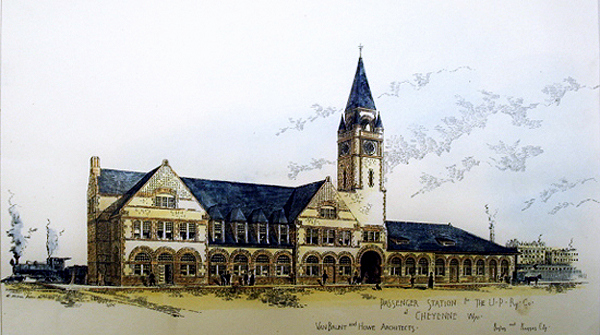
Architectural Rendering, Passenger Station, Cheyenne, W.T., for Union Pacific Ry Co.,
Van Brunt & Howe, Architects, Boston and Kansas City, 1886.
The Railway Station designed by Boston architects Henry Van Brunt and Frank Howe, was done in a
Richardsonesque style promoted by Henry Hobbs Richardon. It is the only one of the grand stations done in the
Richardsonesque manner left standing. The station was completed in 1887. Van Brunt is sometimes included within the
pantheon of American architectural gods along with Richardson, Louis Sullivan and Frank Lloyd Wright. In 1993, the Union Pacific donated the station to
the City of Cheyenne and Laramie County. It now houses on the first floor a museum. South of the station are the Union Pacific
railyards. Unlike other grand American railway stations such as Penn Station in New York, the station has borne little change over the years. The principal changes
over the years have been primarily in the surroundings. The area in front of the station where the Burlington Station once stood has undergone several metamorphoses. As depicted on a later page,
the Burlington Station was razed and replaced by a California-Mediterrean Revival station which in turn was razed, became a parking lot which became a
plaza. The area to the east of the station became a park which disappeared to become the site of a
Greyhound bus station which has itself disappeared. In the 1930's the passenger platform was covered. The covering over the platforms have since been removed. On Fifteen Street to the west of the
station, seedy establishments catering to the lustful desires of lonely drovers are now gone.
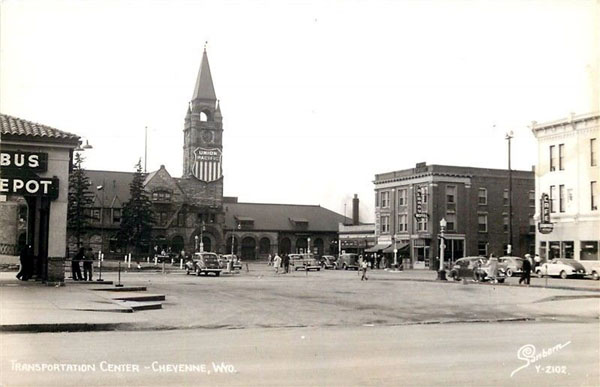
Union Pacific Depot, approx. 1946.
On the right-hand side of the photo is the Albany Hotel, to its right is the
south-east corner of the Edwards Hotel. Between the Burlington Bus Sign and the
Union Pacific Station is the ramp to the Viaduct. The area on beyond the ramp was later
used for the Union Pacifc Greyhound Station.
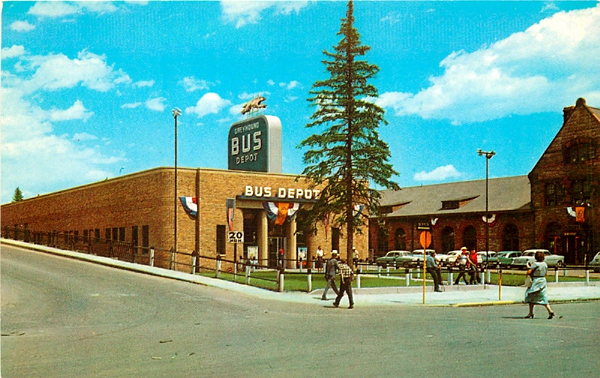
Union Pacific Stages bus station 1950's.
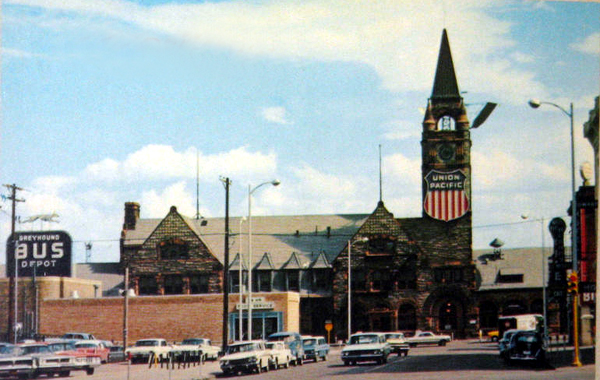
Union Pacific Depot, approx. 1960.
Beginning in the late 1920's, Union Pacific and the Chicago and Northwestern began motor bus operations. Time tables
reflect that prior to the construction of a separate bus station, Union Pacific Stages maintained its Cheyenne office in
in the Albany Hotel. Ultimately after acquisition of Greyhound Pickwick, the Stageline became Greyhound. By the same token,
the Chicago, Burlinton and Quincy formed its own busline, Burlington Stage Lines. It ultimately became affiliated
with Trailways.

Union Pacific Stages coach, 1940.

Burlington Trailways coach.
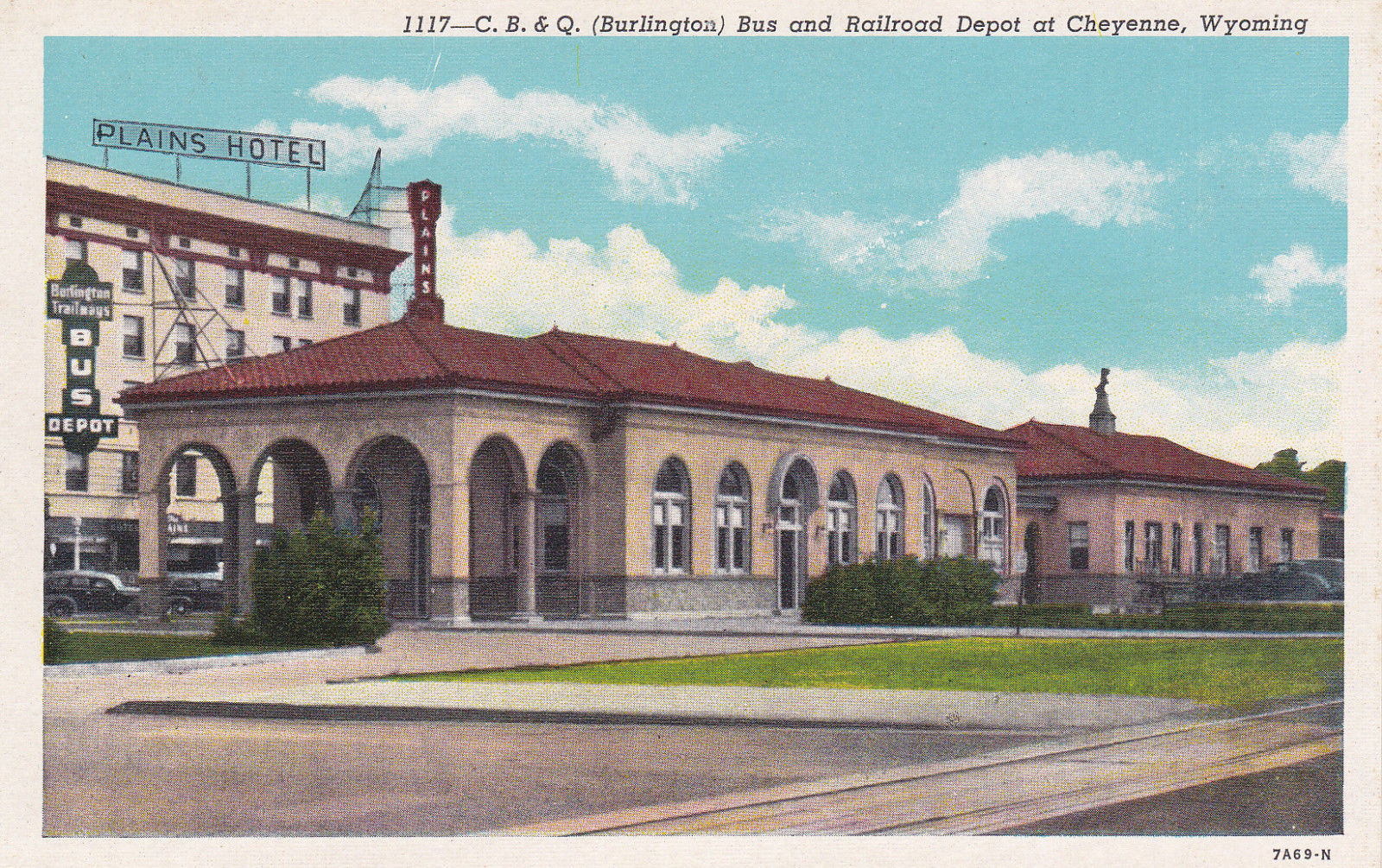
Burlington bus and railroad depot, 1937.
In the distance is the Plains Hotel (see next page) at the time of the photo the leading hotel in Cheyenne. With both railway stations and both national
bus lines having their depots within the same block, the area of the intersection of Lincoln Way and Capitol Ave. was regarded as the
transportation center of Cheyenne.
Both the Burlington Station and the Greyhound Station depicted above are now gone and the area is now Depot Plaza given to various events.
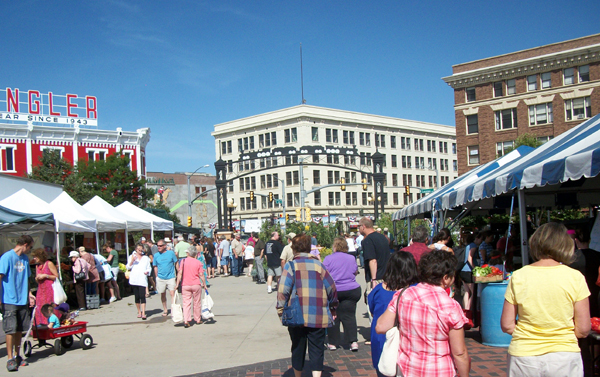
Depot Plaza, 2013. Photo by Geoff Dobson
In the center of the above photo is the Hynds building on the site of the
Inter-Ocean Hotel. To its left is the "hole" caused by the burning of Wyoming Hotel. To its left is the Wrangler
Building. On the right in the photo is the Majestic Building on the northeast corner of
Capitol and Lincoln Way.
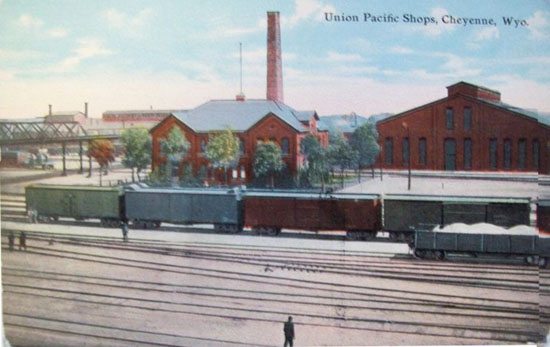
Union Pacific Shops, approx. 1910. Note the viaduct on the left side of the image.
The bulk of the railyards were constructed in 1890 and 1891 pursuant to an agreement with the City under which
the railroad acquired a swath extending a mile and a quarter east and west and a quarter of a mile
wide south of 15th Street and north of 12th Street.
The railyards literally cut Cheyenne off from road traffic to and from the south. The agreements provided that
the City could construct at its own expense two viaducts over the railyards. The railroad made, however, a proposal to construct the
Central Avenue Viaduct with the railroad advancing the cost to be repaid over five years. The viaducts were built in 1891 and 1892
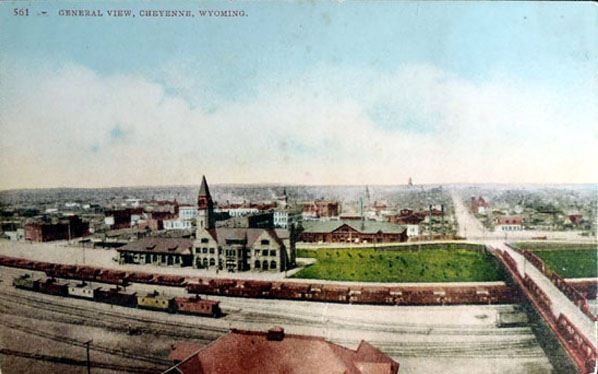
View of Union Pacific and Burlington Depots showing
Central Avenue Viaduct on the left. Brick building on the at the corner of
15th Street and Ferguson (now Carey) is the Metropolitan Hotel discussed on a previous page.
In the above image and next image, note the small trees planted in the greensward. As can be seen, the viaduct was reached by two ramps,
one coming off of Capitol between the Burlington Station and the Union Pacific Station, the other coming from further east in the
area of present-day Warren Avenue. [Please note: with the construction of Business I-25, the viaducts have been rebuilt and
reconfigued].
Union Pacific Depot continued on next page.
|